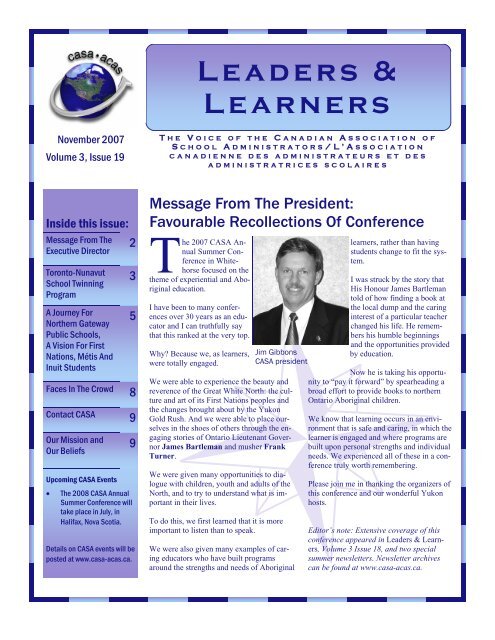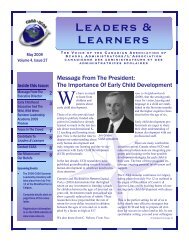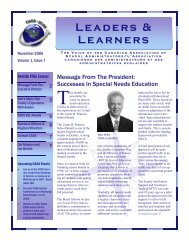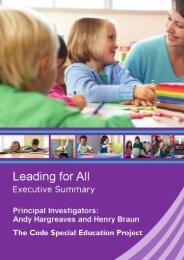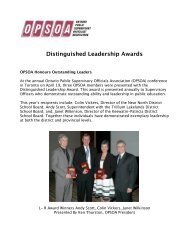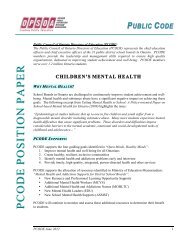Leaders & Learners - Canadian Association of School Administrators
Leaders & Learners - Canadian Association of School Administrators
Leaders & Learners - Canadian Association of School Administrators
Create successful ePaper yourself
Turn your PDF publications into a flip-book with our unique Google optimized e-Paper software.
<strong>Leaders</strong> &<br />
<strong>Learners</strong><br />
November 2007<br />
Volume 3, Issue 19<br />
T HE VOICE OF THE CANADIAN ASSOCIATION OF<br />
S CHOOL ADMINISTRATORS/L’ASSOCIATION<br />
CANADIENNE DES ADMINISTRATEURS ET DES<br />
ADMINISTRATRICES SCOLAIRES<br />
Inside this issue:<br />
2<br />
Message From The<br />
Executive Director<br />
Toronto-Nunavut<br />
<strong>School</strong> Twinning<br />
Program<br />
A Journey For<br />
Northern Gateway<br />
Public <strong>School</strong>s,<br />
A Vision For First<br />
Nations, Métis And<br />
Inuit Students<br />
3<br />
5<br />
Faces In The Crowd<br />
8<br />
Contact CASA<br />
9<br />
Our Mission and<br />
Our Beliefs<br />
9<br />
Upcoming CASA Events<br />
• The 2008 CASA Annual<br />
Summer Conference will<br />
take place in July, in<br />
Halifax, Nova Scotia.<br />
Details on CASA events will be<br />
posted at www.casa-acas.ca.<br />
Message From The President:<br />
Favourable Recollections Of Conference<br />
T<br />
he 2007 CASA Annual<br />
Summer Conference<br />
in Whitehorse<br />
focused on the<br />
theme <strong>of</strong> experiential and Aboriginal<br />
education.<br />
I have been to many conferences<br />
over 30 years as an educator<br />
and I can truthfully say<br />
that this ranked at the very top.<br />
Why? Because we, as learners,<br />
were totally engaged.<br />
Jim Gibbons<br />
CASA president<br />
We were able to experience the beauty and<br />
reverence <strong>of</strong> the Great White North: the culture<br />
and art <strong>of</strong> its First Nations peoples and<br />
the changes brought about by the Yukon<br />
Gold Rush. And we were able to place ourselves<br />
in the shoes <strong>of</strong> others through the engaging<br />
stories <strong>of</strong> Ontario Lieutenant Governor<br />
James Bartleman and musher Frank<br />
Turner.<br />
We were given many opportunities to dialogue<br />
with children, youth and adults <strong>of</strong> the<br />
North, and to try to understand what is important<br />
in their lives.<br />
To do this, we first learned that it is more<br />
important to listen than to speak.<br />
We were also given many examples <strong>of</strong> caring<br />
educators who have built programs<br />
around the strengths and needs <strong>of</strong> Aboriginal<br />
learners, rather than having<br />
students change to fit the system.<br />
I was struck by the story that<br />
His Honour James Bartleman<br />
told <strong>of</strong> how finding a book at<br />
the local dump and the caring<br />
interest <strong>of</strong> a particular teacher<br />
changed his life. He remembers<br />
his humble beginnings<br />
and the opportunities provided<br />
by education.<br />
Now he is taking his opportunity<br />
to “pay it forward” by spearheading a<br />
broad effort to provide books to northern<br />
Ontario Aboriginal children.<br />
We know that learning occurs in an environment<br />
that is safe and caring, in which the<br />
learner is engaged and where programs are<br />
built upon personal strengths and individual<br />
needs. We experienced all <strong>of</strong> these in a conference<br />
truly worth remembering.<br />
Please join me in thanking the organizers <strong>of</strong><br />
this conference and our wonderful Yukon<br />
hosts.<br />
Editor’s note: Extensive coverage <strong>of</strong> this<br />
conference appeared in <strong>Leaders</strong> & <strong>Learners</strong>,<br />
Volume 3 Issue 18, and two special<br />
summer newsletters. Newsletter archives<br />
can be found at www.casa-acas.ca.
<strong>Leaders</strong> & <strong>Learners</strong><br />
Volume 3, Issue 19<br />
Page 2<br />
Message From The Executive Director:<br />
Improving Awareness Of Aboriginal Needs and Contributions<br />
I<br />
n<br />
this issue <strong>of</strong> <strong>Leaders</strong> & <strong>Learners</strong>, you will find a<br />
broad description <strong>of</strong> initiatives for success with Aboriginal<br />
students in Alberta. You will also find a feature<br />
on a partnership project bringing together students from<br />
Toronto and Nunavut. These are good examples <strong>of</strong> welldeveloped,<br />
positive programs led by superintendents who are<br />
making a difference.<br />
In Ontario this year, the Ministry <strong>of</strong> Education has targeted<br />
$4 million to programs in over 25 district school boards with<br />
the goal <strong>of</strong> improving awareness <strong>of</strong> Aboriginal needs and<br />
contributions. Some <strong>of</strong> these programs are aimed at staff<br />
development, some are aimed at development <strong>of</strong> better curriculum;<br />
all programs involved Aboriginal partners. In many<br />
<strong>of</strong> these programs, strategies are used to involve principals<br />
and teachers with Aboriginal cultural leaders.<br />
This government initiative follows upon the good work done<br />
by a number <strong>of</strong> directors <strong>of</strong> education and superintendents at<br />
local levels.<br />
One significant initiative has been the programs for increased<br />
awareness and positive improvement <strong>of</strong> student achievement.<br />
It was developed by the<br />
Northern Ontario Education<br />
<strong>Leaders</strong>hip consortium<br />
<strong>of</strong> several district school<br />
boards based in northern<br />
Ontario.<br />
On November 26 to 28, the<br />
Ontario Ministry <strong>of</strong> Education<br />
is hosting Circle <strong>of</strong><br />
Light: A First Nation, Métis<br />
and Inuit Conference in<br />
Toronto.<br />
This conference will be<br />
Frank Kelly<br />
presented in partnership CASA executive director<br />
with Indian and Northern<br />
Affairs Canada. Many <strong>of</strong> the programs mentioned above<br />
will be featured at this conference.<br />
When the 2007-2008 school year draws to a close, each <strong>of</strong><br />
these programs will be evaluated and best practices published<br />
for sharing.<br />
Consider Nominating A Colleague For The 2008 EXL Award<br />
C<br />
ASA members who show exemplary leadership<br />
ability and who enhance school administration<br />
are eligible for the EXL Award. The<br />
award, jointly sponsored by Xerox Canada<br />
Limited and CASA, has been presented since 2002. It<br />
includes an honorary life membership in CASA.<br />
If you work with an outstanding CASA member or<br />
know a leader in our field who deserves to be recognized,<br />
why not nominate them this year? You can share<br />
your suggestion with the executive director <strong>of</strong> your<br />
provincial association.<br />
What kind <strong>of</strong> qualities should an EXL Award nominee<br />
have?<br />
They will have brought honour to themselves, their<br />
colleagues and their pr<strong>of</strong>ession. They have given exemplary<br />
service to their provincial or national pr<strong>of</strong>essional<br />
association. They have made significant contributions<br />
to the field <strong>of</strong> education through their service,<br />
writings or other activities.<br />
These are individuals who are recognized as role models and<br />
teachers to those around them.<br />
Each provincial association <strong>of</strong> CASA elects a nominee to represent<br />
their province. The national award recipient,<br />
selected from these provincial nominations, is<br />
announced during the opening ceremonies at<br />
the CASA Annual Conference.<br />
Previous winners include John Darroch<br />
(2002), Roy Seidler (2003), Ed Wittchen<br />
(2004), Edie Wilde (2005), Ron Canuel<br />
(2006) and Carol Gray (2007).<br />
The submissions from the provincial associations<br />
for this year are due at the CASA<br />
<strong>of</strong>fice by the end <strong>of</strong> June. Nomination forms<br />
can be found on the CASA website. Completed<br />
forms should be sent to the CASA<br />
<strong>of</strong>fice care <strong>of</strong> Leslea Wylie, by email care <strong>of</strong><br />
leslea@opsoa.org or by fax at (905) 845-<br />
2044.<br />
There are only two<br />
lasting bequests we<br />
can hope to give our<br />
children. One is<br />
roots; the other,<br />
wings.<br />
—Hodding Carter
<strong>Leaders</strong> & <strong>Learners</strong><br />
Volume 3, Issue 19<br />
Page 3<br />
Toronto-Nunavut <strong>School</strong> Twinning Program:<br />
Three Perspectives On The Experience<br />
In this issue <strong>of</strong> <strong>Leaders</strong> & <strong>Learners</strong>, we share the perspectives <strong>of</strong> three staff members from the Toronto District<br />
<strong>School</strong> Board who are engaged firsthand in the Toronto-Nunavut <strong>School</strong> Twinning Program. CASA members who attended<br />
the 2007 conference in Whitehorse may recall the presentation on this program. For those who were unable<br />
to attend the session, we hope you find the following contributions enlightening.<br />
Catherine Pawis is the Toronto District <strong>School</strong> Board’s first central principal responsible for Aboriginal education.<br />
Beverley Muir is the principal at Humberwood Downs Junior Middle Academy, a TDSB school serving students from<br />
junior kindergarten to grade 8. She is also the TDSB Point Person for the Toronto-Nunavut <strong>School</strong> Twinning Program.<br />
Trevor Ludski is the superintendent <strong>of</strong> education for the TDSB. He is also the program coordinator for the Toronto-<br />
Nunavut <strong>School</strong> Twinning Program.<br />
Catherine Pawis: In January 2007, the Ontario government<br />
launched Ontario’s new Aboriginal Education Strategy. The<br />
strategy will help support learning and achievement for<br />
Aboriginal students. In addition, it will help raise awareness<br />
about First Nations, Métis and Inuit peoples’ cultures,<br />
histories and perspectives in schools.<br />
The First Nation, Métis and Inuit Education Policy<br />
Framework is the foundation for delivering quality<br />
education to all First Nations, Métis and Inuit students in<br />
Ontario.<br />
The overriding issues affecting Aboriginal student<br />
achievement are a lack <strong>of</strong> awareness among teachers <strong>of</strong> the<br />
particular learning styles <strong>of</strong> Aboriginal students, and a lack<br />
<strong>of</strong> understanding within schools and school boards <strong>of</strong> First<br />
Nations, Métis and Inuit cultures, histories and perspectives.<br />
It is also important for educators to understand the First<br />
Nations perspective on the school system, which has been<br />
strongly affected by residential school experiences and has<br />
resulted in intergenerational mistrust <strong>of</strong> the education<br />
system.<br />
It is essential that First Nations, Métis and Inuit students are<br />
engaged and feel welcomed in school, and that they see<br />
themselves and their cultures in the curriculum and the<br />
school community. It is equally important that all students<br />
in Ontario acquire knowledge and an appreciation <strong>of</strong><br />
contemporary and traditional First Nations, Métis and Inuit<br />
cultures, histories and perspectives.<br />
The Toronto-Nunavut <strong>School</strong> Twinning Program facilitates<br />
intercultural dialogue, so that students and staff in Toronto<br />
schools learn about contemporary and traditional Inuit<br />
cultures, histories and perspectives. Additionally, the<br />
program creates learning opportunities for students in<br />
Nunavut schools that support improved academic<br />
achievement and identity building. Accordingly, the<br />
Toronto-Nunavut <strong>School</strong> Twinning Program supports the<br />
implementation <strong>of</strong> the Ontario First<br />
Nation, Métis and Inuit Education<br />
Policy Framework.<br />
Beverley Muir: How wonderful<br />
visions are! They beckon us on to<br />
venture into new areas <strong>of</strong> selfdiscovery<br />
and in turn discovery for<br />
our students. The Toronto-Nunavut<br />
<strong>School</strong> Twinning Program is rooted<br />
in His Honour James Bartleman’s<br />
vision and it allows us to begin this<br />
discovery process.<br />
The implementation <strong>of</strong> the vision has<br />
many steps. In the Toronto District<br />
<strong>School</strong> Board, schools responded to<br />
(Continued on page 4)<br />
If we don’t stand up<br />
for children, then we<br />
don’t stand for<br />
much.<br />
—Marian Wright<br />
Edelman
<strong>Leaders</strong> & <strong>Learners</strong><br />
Volume 3, Issue 19<br />
Page 4<br />
Toronto-Nunavut <strong>School</strong> Twinning Program, continued<br />
(Continued from page 3)<br />
an invitation to be twinned with a school in Nunavut.<br />
Through a contact with the Nunavut Teacher’s<br />
Federation, this program took root there.<br />
Due to the size <strong>of</strong> TDSB, schools in a given<br />
geographical area were grouped into clusters, with a<br />
principal being a cluster coordinator to provide<br />
leadership for the cluster <strong>of</strong> schools.<br />
Putting a schedule in place to facilitate the twinning is<br />
just one part <strong>of</strong> the implementation. The building <strong>of</strong><br />
trusting relationships is another.<br />
With so many wounds <strong>of</strong> distrust and disappointment<br />
present in the Aboriginal community, we needed to take<br />
time to do this. As dialogue started to occur, circles <strong>of</strong><br />
trust were formed. So the question for the schools in<br />
Toronto to the schools in Nunavut was no longer “What<br />
can we send you?” but “Tell us about your school and<br />
the values <strong>of</strong> the community.” Common understandings<br />
started to emerge.<br />
The exchange <strong>of</strong> information started to include artwork;<br />
biographical sketches <strong>of</strong> our respective communities;<br />
sending a DVD; and sending shoes, backpacks and<br />
disposable cameras so Nunavut schools could send us<br />
photos that students had taken <strong>of</strong> their schools.<br />
One Toronto school sent a grade 8 teacher, a rep from<br />
IBM and a principal to Resolute Bay to have a computer<br />
camp for a week with their twinned school. It included a<br />
video conference with their home school in Toronto<br />
where the students exchanged web pages and the<br />
Lieutenant Governor spoke to the students in Resolute<br />
Bay.<br />
Two independent schools in Toronto are also involved,<br />
and they have sent a considerable amount <strong>of</strong> hockey<br />
equipment to their schools. The Toronto Catholic <strong>School</strong><br />
Board has had system events to help students understand<br />
life in the Arctic such as the Arctic Games, and two<br />
classes have visited their school in the north and have<br />
had a return visit to Toronto.<br />
As we step back and reflect on the beginnings and early<br />
implementation <strong>of</strong> the Twinning Program, we realize<br />
that we have been afforded a rich opportunity to enter<br />
into the lives <strong>of</strong> our Aboriginal students and their<br />
communities. Gratitude is our song. We believe this is<br />
our moral imperative. We can do no less...and we will<br />
do more.<br />
Vice-regal Assistance:<br />
TDSB’s superintendent <strong>of</strong><br />
education Trevor Ludski<br />
was invited by the Honourable<br />
James Bartleman<br />
(right) to develop the Toronto-Nunavut<br />
<strong>School</strong><br />
Twinning Program.<br />
The former Lieutenant<br />
Governor <strong>of</strong> Ontario, as<br />
well as his current successor,<br />
has pledged to<br />
continue to contribute to<br />
this program on a voluntary<br />
basis.<br />
Trevor Ludski: The Honourable James K. Bartleman, former<br />
Lieutenant Governor <strong>of</strong> Ontario, included support for<br />
Aboriginal youth as part <strong>of</strong> his mandate. His Honour<br />
envisioned a cultural twinning program between Toronto<br />
schools and Nunavut schools.<br />
As superintendent <strong>of</strong> education for TDSB with responsibility<br />
for supporting Aboriginal education, I was invited by His<br />
Honour to develop and coordinate a program that included the<br />
Toronto District <strong>School</strong> Board, the Toronto Catholic District<br />
<strong>School</strong> Board, two independent schools in Toronto and 42<br />
schools across the territory <strong>of</strong> Nunavut.<br />
I embraced His Honour’s vision by sharing the potential for<br />
learning among students, staff, parents<br />
and community members with my<br />
colleagues.<br />
Together, we grew His Honour’s vision<br />
by communicating it to others and by<br />
building support for the vision. We did<br />
this by providing forums where the<br />
vision could be caught and shared.<br />
For example, over 160 inner city<br />
students from both the elementary and<br />
secondary panels at TDSB schools spent<br />
a summer at York University where they<br />
participated in drama, dance, art and<br />
music activities based on the theme<br />
Journey to Nunavut. A student-led<br />
(Continued on page 9)<br />
There are no seven<br />
wonders <strong>of</strong> the<br />
world in the eyes <strong>of</strong><br />
a child. There are<br />
seven million.<br />
—Walt Streightiff
<strong>Leaders</strong> & <strong>Learners</strong><br />
Volume 3, Issue 19<br />
Page 5<br />
A Journey For Northern Gateway Public <strong>School</strong>s,<br />
A Vision For First Nations, Métis And Inuit Students<br />
The division <strong>of</strong> Northern Gateway Public <strong>School</strong>s spans nearly 375 km from end to end. Its schools are in the communities<br />
situated around the Highway 43 corridor northeast <strong>of</strong> Edmonton, which include Alberta Beach, Onoway,<br />
Rich Valley, Darwell, Sanguda, Mayerthorpe, Whitecourt, Fox Creek, Valleyview and Sunset House. The district also<br />
has two Hutterite colony schools at Twilight Colony and Valleyview Ranches Colony. It is a primarily rural area with a<br />
mixed agricultural- and resource-based economy.<br />
<strong>School</strong>s in the division range from an 11-student, one-room Hutterite colony school to a junior/senior high school<br />
with nearly 700 students. The K-12 student population is 5,300.<br />
Roger Lacey is the division’s learning services coordinator. Michelle Brennick is Northern Gateway’s assistant superintendent.<br />
This is their first contribution to <strong>Leaders</strong> & <strong>Learners</strong>.<br />
T<br />
his is the story <strong>of</strong> a journey; a journey<br />
that has begun. The story has neither<br />
a climax nor a denouement—yet.<br />
In the year 2006, the freshly appointed superintendent<br />
for Northern Gateway Public <strong>School</strong>s<br />
discovered something about his new school division that<br />
both opened his eyes and caused him concern.<br />
He found that he had in his care over 800 registered students<br />
who fulfilled the qualifications for First Nations, Métis<br />
and Inuit (FNMI) learners. This significant portion <strong>of</strong> the<br />
student population required support in areas <strong>of</strong> curriculum,<br />
instruction and counselling that would answer the needs <strong>of</strong><br />
children from an Aboriginal cultural background.<br />
The superintendent directed the division Learning Services<br />
team to begin an initial investigation. This investigation led<br />
the team to several foundational documents produced<br />
through Alberta Education. Among this compilation, one<br />
book stood out. The volume, entitled Our Words, Our<br />
Ways: Teaching First Nations, Métis and Inuit <strong>Learners</strong><br />
(Aboriginal Services), provided insights and direction for<br />
the journey.<br />
It was clear that Northern Gateway needed a vision for the<br />
education <strong>of</strong> its FNMI students. However, before a sustainable<br />
vision could be built, there was considerable research<br />
to be done. A survey <strong>of</strong> the FNMI population <strong>of</strong> the school<br />
division revealed that students, while generally spread out<br />
along the 375 km corridor <strong>of</strong> Highway 43, were concentrated<br />
at either end in Native communities near Onoway in<br />
the south and Valleyview in the north. Both <strong>of</strong> these communities<br />
sent students to the public schools as a result <strong>of</strong><br />
signed agreements with Northern Gateway.<br />
Near Onoway is the Alexis First Nation <strong>of</strong> the Stoney or<br />
By Roger Lacey<br />
and Michelle Brennick<br />
Nakoda Sioux people whose traditional language is Nakoda/Stoney.<br />
Near Valleyview, the Western Cree live in the<br />
community <strong>of</strong> Sturgeon Lake. Research showed that the<br />
schools <strong>of</strong> Northern Gateway could serve the needs <strong>of</strong><br />
FNMI students through awareness and pedagogy. This realization<br />
sharpened the focus for the Vision Document and<br />
led to the undertaking <strong>of</strong> a journey toward two goals.<br />
The goals that Northern Gateway has adopted align with<br />
those outlined in the Alberta government document First<br />
Nations, Métis and Inuit Education Policy Framework. The<br />
two goals emphasized in the Vision Document are:<br />
1. high quality learning opportunities<br />
that are responsive, flexible, accessible<br />
and affordable to the<br />
learner<br />
2. excellence in Learner achievement<br />
The goals have become division priorities,<br />
expressed in the Vision Document<br />
as “Priority Number One: Student<br />
Achievement” and “Priority<br />
Number Two: Culturally Relevant<br />
Learning Opportunities.”<br />
It has been a combination <strong>of</strong> focused<br />
effort on good pedagogy and just<br />
plain serendipity that allowed the<br />
(Continued on page 6)<br />
What we have is<br />
because someone<br />
stood up before us.<br />
What our Seventh<br />
Generation will have<br />
is a consequence <strong>of</strong><br />
our actions today.<br />
—Winona LaDuke
<strong>Leaders</strong> & <strong>Learners</strong><br />
Volume 3, Issue 19<br />
Page 6<br />
A Journey For Northern Gateway Public <strong>School</strong>s, continued<br />
(Continued from page 5)<br />
beginning stages <strong>of</strong> implementation <strong>of</strong> the strategies that<br />
would help Northern Gateway move toward achieving the<br />
stated goals.<br />
Alberta Education has done two things that have<br />
had an impact on the direction taken by Northern<br />
Gateway. The government has introduced new<br />
curricula in Social Studies and in Mathematics.<br />
Both <strong>of</strong> the new Programs <strong>of</strong> Studies pay special<br />
attention to FNMI learners. At about the same<br />
time, the Alberta government put out a call for<br />
school divisions to submit proposals to run pilot<br />
projects in the area <strong>of</strong> mobile computing technology.<br />
Northern Gateway embraced both <strong>of</strong><br />
these opportunities.<br />
Impact <strong>of</strong> Curriculum on FNMI Education<br />
in Northern Gateway<br />
Northern Gateway brought the education <strong>of</strong> FNMI students<br />
to the fore in all the in-service sessions facilitated in the<br />
division.<br />
In the pr<strong>of</strong>essional development sessions, the use <strong>of</strong> Aboriginal<br />
artifacts is an integral part <strong>of</strong> showing teachers how<br />
they can fulfill the curriculum. The artifact display reveals<br />
that everything has a history and Native artifacts reveal the<br />
story from an Aboriginal perspective. This sharing heightens<br />
the awareness and understanding <strong>of</strong> Native peoples<br />
among teachers.<br />
When teachers return to their classes and use these artifacts,<br />
two things should occur. If there are Aboriginal students in<br />
the classroom, the use <strong>of</strong> Native artifacts creates a pride in<br />
their heritage because it creates a pride in their story. If on<br />
the other hand there are no Aboriginal students in the classroom,<br />
the artifact raises an awareness <strong>of</strong> a founding peoples’<br />
perspective—the Aboriginal perspective.<br />
Embedded within the teaching are the goals <strong>of</strong> citizenship<br />
and identity. In one <strong>of</strong> the Social Studies pr<strong>of</strong>essional development<br />
sessions, guest speaker Angie Hall, Aboriginal Coordinator<br />
with the Edmonton Catholic <strong>School</strong> District,<br />
shared her personal Aboriginal story and demonstrated a<br />
method by which all children can be encouraged to share<br />
their stories. The teachers <strong>of</strong> Northern Gateway learned<br />
about the use <strong>of</strong> the storybag—a person’s collection <strong>of</strong><br />
small, significant items that aid the memory for oral storytelling.<br />
Teachers were excited to take this Native method<br />
for storytelling back to their classrooms.<br />
As the teachers saw the value <strong>of</strong> using artifacts in the classroom,<br />
they suggested that a travelling collection <strong>of</strong> artifacts<br />
be created to help them use the techniques they had learned.<br />
They understand<br />
the power <strong>of</strong> the<br />
objects to encourage<br />
an understanding<br />
<strong>of</strong> the oral tradition<br />
<strong>of</strong> Aboriginal<br />
peoples, thus<br />
bringing together<br />
the use <strong>of</strong> artifacts<br />
and the storybag.<br />
The fur-trading kit,<br />
relevant to many<br />
areas <strong>of</strong> the Social<br />
Studies curriculum, is making its school debut in the latter<br />
part <strong>of</strong> November 2007.<br />
The teachers <strong>of</strong> Northern Gateway<br />
learned about the use <strong>of</strong><br />
the storybag—a person’s<br />
collection <strong>of</strong> small, significant items<br />
that aid the memory<br />
for oral storytelling.<br />
In tandem, Northern Gateway hosted a session that was<br />
facilitated by two Alberta Education FNMI specialists. The<br />
entire administrative team—superintendent, deputy superintendent,<br />
assistant superintendent, learning services coordinators,<br />
principals and assistant principals—was exposed to<br />
the background and possibilities for Aboriginal education.<br />
The education managers focused on key Alberta Education<br />
documents to highlight their message <strong>of</strong> student success<br />
through engagement. This information built on the understanding<br />
gained from attending The Spirit <strong>of</strong> the Children<br />
provincial conference in March 2007.<br />
The educators <strong>of</strong> Northern Gateway found that a study <strong>of</strong><br />
Our Words, Our Ways served to reinforce their conviction<br />
that good pedagogy is good pedagogy<br />
no matter what the context. Areas <strong>of</strong><br />
emphasis in Northern Gateway’s Pr<strong>of</strong>essional<br />
Development Plan included<br />
Differentiated Instruction, Assessment<br />
for Learning and Student Engagement.<br />
These were also in Our<br />
Words, Our Ways as useful pedagogical<br />
practices when helping the Aboriginal<br />
learner.<br />
Skill to do<br />
Impact <strong>of</strong> Technology on FNMI<br />
Education in Northern Gateway<br />
When Northern Gateway’s project<br />
<strong>Learners</strong> Without Borders was accepted,<br />
it provided an excellent op-<br />
(Continued on page 7)<br />
comes <strong>of</strong> doing.<br />
—Ralph Waldo<br />
Emerson
<strong>Leaders</strong> & <strong>Learners</strong><br />
Volume 3, Issue 19<br />
Page 7<br />
A Journey For Northern Gateway Public <strong>School</strong>s, continued<br />
(Continued from page 6)<br />
portunity to better serve FNMI learners. The project is<br />
based on the premise that mobile computing (laptops) given<br />
as teaching and learning tools to grade 4 students and kept<br />
for three years by these students will move them toward<br />
excellence in achievement, foster 21st-century skills and<br />
provide a way for diverse student cultures (FNMI) to become<br />
part <strong>of</strong> the learning community.<br />
Our FNMI students in grade 4 at schools in Onoway and<br />
Valleyview would now have the means to learn anywhere,<br />
at any time.<br />
The target schools are searching for ways to improve the<br />
achievement <strong>of</strong> their FNMI students. They understand that<br />
Aboriginal students may not respond to the traditional ways<br />
that non-Aboriginal students are taught. They also realize<br />
the benefit <strong>of</strong> assistive technologies to FNMI students:<br />
Although assistive technology for learning may be<br />
aimed at the needs <strong>of</strong> a particular student, it is<br />
also possible to use assistive technology to benefit<br />
a wide range <strong>of</strong> students.<br />
(Our Words, Our Ways, p. 40)<br />
Existing research provides a hopeful vision for the teachers<br />
and students in the two schools. The “Main Learning Technology<br />
Initiative” showed that “students have more choice,<br />
opportunity and flexibility within the one-to-one, high<br />
speed, wireless computing classroom.”<br />
It is the elements <strong>of</strong> choice and flexibility that can enhance<br />
the Aboriginal student’s learning. The ability to take their<br />
learning tools with them in the form <strong>of</strong> laptop computers<br />
allows the students to learn in many different locations and<br />
at diverse times.<br />
The use <strong>of</strong> mobile technology has had positive effects for<br />
all students according to the research summarized and confirmed<br />
by James Gulek and Hakan Demartis in their article,<br />
“Learning with Technology: The Impact <strong>of</strong> Laptop Use on<br />
Student Achievement” in the Journal <strong>of</strong> Technology, Learning<br />
and Assessment (January 2005):<br />
Past research suggests that compared to their nonlaptop<br />
counterparts, students...with their own laptops<br />
spend more time involved in collaborative<br />
work, participate in more project-based instructtion,<br />
produce writing <strong>of</strong> higher quality and greater<br />
length, gain increased access to information, improve<br />
research analysis skills, and spend more<br />
time doing homework on computers.<br />
Of special interest with regard to FNMI students are the<br />
benefits reported from the Maine Education Policy Research<br />
Institute (MEPR) including “‘students’ engagement<br />
and attendance were up, behaviour referrals were<br />
down” (Muir, 2004).<br />
This is month three <strong>of</strong> year one <strong>of</strong> this project. The five<br />
teachers and two principals who are directly involved in this<br />
initiative are exploring new ways <strong>of</strong> teaching and learning.<br />
Impact <strong>of</strong> FNMI Coordinator on FNMI Education<br />
in Northern Gateway<br />
As the superintendent gained a deeper understanding <strong>of</strong> the<br />
need to enhance the delivery <strong>of</strong> FNMI education in Northern<br />
Gateway, he dedicated funding to support a school division<br />
FNMI coordinator.<br />
This new position has given the division a person who can<br />
focus his energy on providing educational services across<br />
the division.<br />
His first mission is to assess what every school is currently<br />
implementing in the way <strong>of</strong> educational services for Aboriginal<br />
students.<br />
His next assignment will be to collect and collate hard data<br />
so that an accurate FNMI achievement picture can be<br />
drawn. The information gathered from principals will be<br />
compiled, and common themes, queries and concerns will<br />
be identified. The goal is to have a comprehensive package<br />
ready to present to Northern Gateway administrators by the<br />
end <strong>of</strong> February 2008.<br />
Northern Gateway, as an entire division,<br />
has become acutely aware <strong>of</strong> the<br />
challenges presented by the need to<br />
serve the education <strong>of</strong> a significant<br />
FNMI population. Background work<br />
has been done with much still left to<br />
do. Initiatives have begun that will<br />
need to be sustained and assessed.<br />
Northern Gateway’s journey is not<br />
that different from any taken when<br />
there is a realization <strong>of</strong> the need to<br />
take that journey.<br />
Northern Gateway has a vision for<br />
where it must go and has taken the<br />
first steps to get there.<br />
History, despite its<br />
wrenching pain,<br />
cannot be unlived,<br />
but if faced with<br />
courage, need not be<br />
lived again.<br />
—Maya Angelou
<strong>Leaders</strong> & <strong>Learners</strong><br />
Volume 3, Issue 19<br />
CASA PEOPLE:<br />
Faces In The Crowd<br />
Page 8<br />
Lucie La Ferrière<br />
Quebec<br />
Lucie is the assistant director general<br />
<strong>of</strong> the Lester B. Pearson <strong>School</strong><br />
Board in Montreal, a post she assumed<br />
after having served as director<br />
<strong>of</strong> Pedagogical Services. In her 30-<br />
year career, she has been a teacher<br />
and a principal at elementary, secondary<br />
and alternative schools. She also<br />
served as a pedagogical consultant in<br />
elementary education.<br />
She has shown particular interest and<br />
skills in youth education and in those<br />
children with special needs. She has<br />
also worked with the board’s infrastructure<br />
needs and in all matters <strong>of</strong><br />
pedagogical interest. She holds firm<br />
her belief in the wonderful abilities <strong>of</strong><br />
all children and her conviction that<br />
all children can learn and succeed.<br />
She is committed to teamwork, collective<br />
leadership and youth.<br />
She is the loving wife <strong>of</strong> Claude and<br />
mother to two wonderful children.<br />
Robin Shepherd<br />
Ontario<br />
Robin is on a secondment to the Student<br />
Success/Learning to 18 Strategic<br />
Policy Branch <strong>of</strong> the Ontario Ministry<br />
<strong>of</strong> Education. In her Ministry role,<br />
Robin is the lead writer for the new<br />
secondary policy document. She also<br />
has the co-lead for the new Ontario<br />
policies around equivalent learning.<br />
Since 1980, Robin has taught secondary<br />
school subjects ranging from<br />
Physics to English to Guidance. This<br />
diversity <strong>of</strong> curriculum knowledge<br />
supported her success as vice principal<br />
and principal in the former city <strong>of</strong><br />
York, and as a supervisory <strong>of</strong>ficer for<br />
the last 11 years with the Toronto<br />
District <strong>School</strong> Board. She has had a<br />
variety <strong>of</strong> Family <strong>of</strong> <strong>School</strong>s responsibilities<br />
and central positions in the<br />
Program Department <strong>of</strong> the board.<br />
In between revising policy, Robin<br />
loves to travel the world with her<br />
husband Angelo, a retired principal.<br />
Lorne Rachlis<br />
Ontario<br />
Lorne is director <strong>of</strong> education and<br />
secretary <strong>of</strong> the board for the Ottawa-Carleton<br />
District <strong>School</strong> Board.<br />
In the early years <strong>of</strong> his career,<br />
Lorne was a chemistry and math<br />
teacher, then principal and finally<br />
head <strong>of</strong> adult education at Bathurst<br />
Heights Secondary <strong>School</strong> in North<br />
York. He then held a number <strong>of</strong> education<br />
leadership positions in the<br />
Ottawa region, and lectured at the<br />
University <strong>of</strong> Saskatchewan. From<br />
1998 to 2003, he was director <strong>of</strong><br />
education and secretary-treasurer for<br />
the Avon Maitland District <strong>School</strong><br />
Board in southwestern Ontario.<br />
Lorne has sat on many education<br />
organization executives and community<br />
boards. He has received numerous<br />
awards throughout his career and<br />
has been published a number <strong>of</strong><br />
times in education journals and<br />
newsletters.
Contact CASA:<br />
1123 Glenashton Drive<br />
Oakville, ON<br />
L6H 5M1<br />
Canada<br />
T: (905) 845-2345<br />
F: (905) 845-2044<br />
frank_kelly@opsoa.org<br />
leslea@opsoa.org<br />
www.casa-acas.ca<br />
Editor: Tara Lee Wittchen<br />
©2007 CASA<br />
Our Mission:<br />
CASA will advance quality public education<br />
and excellence in system level leadership<br />
through advocacy and national collaboration.<br />
Our Beliefs:<br />
CASA believes that:<br />
• Cultural diversity is a unique strength that enriches our nation.<br />
• Communication and collaboration with parents and other partners<br />
is integral to successful student learning.<br />
• Quality public education provides the best opportunity for a nation<br />
to enhance the lives <strong>of</strong> all its citizens.<br />
• Effective system, provincial and national level leadership enables<br />
and supports excellence in teaching and learning.<br />
• A comprehensive education, equitable and accessible to all, is the<br />
key to meeting the diverse needs and securing a successful future<br />
for our youth.<br />
Specific strategies to advance the mission:<br />
• Establish position papers on specific topics as they relate to the<br />
beliefs and interests <strong>of</strong> the association.<br />
• Recruit new people.<br />
• Establish a national representation.<br />
• Establish a three-tier public relations and publications strategy.<br />
• Establish a funding team to create an operating budget.<br />
Toronto-Nunavut <strong>School</strong> Twinning Program, continued<br />
(Continued from page 4)<br />
presentation <strong>of</strong> their summer program was shared with His<br />
Honour in the fall.<br />
from the newly appointed Lieutenant Governor <strong>of</strong> Ontario,<br />
the Honourable David Onley, has agreed to continue this<br />
work on a voluntary basis.<br />
Another example <strong>of</strong> building support for His Honour’s<br />
vision was a Winter Arctic Games Day organized by the<br />
Toronto Catholic District <strong>School</strong> Board. Inuit students from<br />
Ottawa were invited to lead the activities. His Honour was<br />
the special guest for this day.<br />
Principals and teachers have demonstrated strong leadership<br />
both at the district level as well as in their schools by<br />
developing partnerships with their counterparts across<br />
Nunavut. Furthermore, partnerships with corporations such<br />
as IBM have resulted in wonderful communication<br />
opportunities for students, staff and community members<br />
using broadband technology.<br />
One <strong>of</strong> the challenges faced by all <strong>of</strong> us is maintaining the<br />
program and building succession due to the annual turnover<br />
<strong>of</strong> administrators and teaching staff in Nunavut schools. We<br />
continue to work with the president <strong>of</strong> the Federation <strong>of</strong><br />
Nunavut Teachers to address this challenge.<br />
The Honourable James K. Bartleman, along with support<br />
To conclude, as an educator I view this program, along<br />
with all the accompanying experiences, as a highly<br />
enriching pr<strong>of</strong>essional development opportunity.<br />
It teaches me to build trust, to learn to challenge my<br />
ethnocentricism, to reflect on who I am and what I value as<br />
a <strong>Canadian</strong> when my world view collides. I am learning to<br />
be more patient, to take ownership for what I do, to<br />
challenge my own assumptions, and most importantly, I am<br />
learning to continue to move myself along a continuum that<br />
teaches me to strive to be a better human being.<br />
I cannot lead where I have not been.<br />
I believe that the seeds we sow today will continue to grow<br />
in the hearts and minds <strong>of</strong> all that support the vision <strong>of</strong> the<br />
Honourable James K. Bartleman because <strong>of</strong> the strong<br />
moral imperative attached to this program. I believe that<br />
the program will continue to take root in our schools.<br />
I live in hope.


